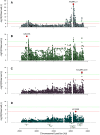Integration of Genetic and Clinical Risk Factors for Risk Classification of Uveitis in Patients With Juvenile Idiopathic Arthritis
- PMID: 39030878
- PMCID: PMC11605271
- DOI: 10.1002/art.42955
Integration of Genetic and Clinical Risk Factors for Risk Classification of Uveitis in Patients With Juvenile Idiopathic Arthritis
Abstract
Objective: Juvenile idiopathic arthritis (JIA)-associated uveitis (JIAU) is a serious JIA comorbidity that can result in vision impairment. This study aimed to identify genetic risk factors within the major histocompatibility complex for JIAU and evaluate their contribution for improving risk classification when combined with clinical risk factors.
Methods: Data on single nucleotide polymorphisms, amino acids, and classical HLA alleles were available for 2,497 patients with JIA without uveitis and 579 patients with JIAU (female 2,060, male 1,015). Analysis was restricted to patients with inferred European ancestry. Forward conditional logistic regression identified genetic markers exceeding a Bonferroni-corrected significance (6 × 10-6). Multivariable logistic regression estimated the effects of clinical and genetic risk factors, and a likelihood ratio test calculated the improvement in model fit when adding genetic factors. Uveitis risk classification performance of a model integrating genetic and clinical risk factors was estimated using area under the receiver operator characteristic curve and compared with a model of clinical risk factors alone.
Results: Three genetic risk factors were identified, mapping to HLA-DRB1, HLA-DPB1, and HLA-A. These markers were statistically independent from clinical risk factors and significantly improved the fit of a model when included with clinical risk factors (P = 3.3 × 10-23). The addition of genetic markers improved the classification of JIAU compared with a model of clinical risk factors alone (area under the curve 0.75 vs 0.71).
Conclusion: Integration of a genetic and clinical risk prediction model outperforms a model based solely on clinical risk factors. Future JIAU risk prediction models should include genetic risk factors.
© 2024 The Author(s). Arthritis & Rheumatology published by Wiley Periodicals LLC on behalf of American College of Rheumatology.
Figures

References
-
- Grassi A, Corona F, Casellato A, et al. Prevalence and outcome of juvenile idiopathic arthritis‐associated uveitis and relation to articular disease. J Rheumatol 2007;34:1139–1145. - PubMed
-
- Haasnoot AMJW, Schilham MW, Kamphuis S, et al; ICON‐JIA Study Group . Identification of an amino acid motif in HLA–DRβ1 that distinguishes uveitis in patients with juvenile idiopathic arthritis. Arthritis Rheumatol 2018;70:1155–1165. - PubMed
-
- Sen ES, Ramanan AV. Juvenile idiopathic arthritis‐associated uveitis. Clin Immunol 2020;211:108322. - PubMed
-
- Sen ES, Dick AD, Ramanan AV. Uveitis associated with juvenile idiopathic arthritis. Nat Rev Rheumatol 2015;11:338–348. - PubMed
MeSH terms
Substances
Grants and funding
- 08ICH09/Sparks UK
- VS0518/Great Ormond Street Hospital Charity
- 21754/Centre for Genetics and Genomics Versus Arthritis
- 21755/Centre for Epidemiology Versus Arthritis, University of Manchester
- MR/M004600/1/MRC_/Medical Research Council/United Kingdom
- MR/R013926/1/MRC_/Medical Research Council/United Kingdom
- 19612/ARC_/Arthritis Research UK/United Kingdom
- 20659/ARC_/Arthritis Research UK/United Kingdom
- 20747/ARC_/Arthritis Research UK/United Kingdom
- 20542/VAC_/Versus Arthritis/United Kingdom
- 20621/VAC_/Versus Arthritis/United Kingdom
- 21593/VAC_/Versus Arthritis/United Kingdom
- 22084/VAC_/Versus Arthritis/United Kingdom
LinkOut - more resources
Full Text Sources
Medical
Research Materials

